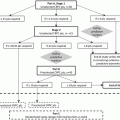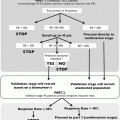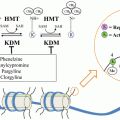Fig. 11.1
Periodic table
For the bone-targeted radiopharmaceuticals such as Sm-153 EDTMP, strontium-89 (Sr-89), radium-223 (Ra-223), and phosphorus-32 (P-32), as well as the bisphosphonates, bone targeting occurs via hydroxyapatite Ca5(PO4)3(OH) binding [8]. Hydroxyapatite is an essential portion of the inorganic matrix of bone and is inter-mixed with cancer cells in lesions with an osteoblastic phenotype. Targeting radioactive compounds to hydroxyapatite is also performed clinically when using technetium-99 linked methylene diphosphonate (MDP) bone scans or sodium fluoride (F18) bone scans. When imaging bone lesions with either of these agents, the actual radiopharmaceutical complex is within the hydroxyapatite within the regions of interest.
Beta-Emitting Radiopharmaceuticals: A Brief Overview
The first use of a bone-targeted radiopharmaceutical involved phosphorus-32 (P-32). In 1950, it was reported by Friedell and Storaasli [9] that bone metastatic breast cancer could be palliated after treatment with intravenous P-32. The first use of a radiopharmaceutical in bone-metastatic prostate cancer was reported by Maxfield, Maxfield, and Maxfield in 1958 [10]. Though efficacious, P-32 is rarely used today in the United States in part due to myelosuppression.
Three bone-targeted radiopharmaceuticals are currently FDA approved and in common use in the United States. These include Sr-89, Sm-153-EDTMP, and Ra-223. The strontium and samarium radionuclides are beta particle emitters but the radium nuclide is an alpha particle emitter.
Sr-89 beta particles are emitted with a higher energy as compared to Sm-153 [11]. The tissue penetration of the particles is proportional to energy, thus the particles emitted by Sr-89 are penetrative than those of Sm-153. For Sr-89, the average beta energy is 0.580 MeV. For the Sm-153, the average betas are 0.23 MeV. The tissue penetration is approximately 2.4 mm for betas derived from Sr-89 and approximately 0.5 mm for betas derived from Sm-153. The Sr-89 half-life is 50.5 days. The half-life for Sm-153 is approximately 1.9 days. Sm-153 has an energetic gamma emission which allows this agent to be used for imaging as well. A placebo-controlled randomized trial was pivotal for FDA approval of Sr-89. A total of 126 metastatic castrate-resistant prostate cancer (CRPC) patients were randomized to intravenous Sr-89 at a dose of 10.8 mCi or an intravenous placebo [12]. A higher percentage of patients in the strontium arm stopped analgesics 3 months after injection (17 versus 2 %). New painful bone lesions were also tracked prospectively. Three months post-injection, 59 % of patients in the placebo arm had new painful lesions compared to 34 % of Sr-89 treated patients. Grade 4 low platelets were noted in 10.4 % of Sr-89 treated patients.
Two randomized placebo-controlled trials were pivotal for the FDA approval of Sm-153 EDTMP in painful bone-metastatic CRPC patients. The first trial [13] utilized a heterogenous group of bone-metastatic cancer patients, but nearly two-thirds had prostate cancer. Patients were randomized to Sm-152 (non-radioactive) combined with EDTMP or Sm-153-EDTMP at two doses (0.5 mCi/kg or 1 mCi/kg). The trial was double blinded and utilized pain as a primary endpoint. A total of 72 % of patients randomized to receive 1.0 mCi/kg Sm-153-EDTMP had pain relief within or at 4 weeks of treatment. Thrombocytopenia and leukopenia decreased to a grade 3 level in 3 and 14 % of patients in this radionuclide arm but recovery by 8 weeks was typical.
A second Sm-153-EDTMP placebo-controlled randomized trial [14] was conducted in 152 bone metastatic CRPC. Patients were randomized 2:1 to receive a 1.0 mCi/kg dose of the radiopharmaceutical of or placebo. Pain relief was the primary endpoint. A reduction in pain and analgesic consumption was noted 3–4 after the injection and 38 % of patients treated with Sm reported complete pain relief compared to 18 % of patients treated with placebo. Grade 3 decreased in platelets and white cells were documented in 3 and 5 % of Sm patients, respectively.
Distinctions Between Alpha and Beta Particles
Both Sr-89 and Sm-153 are beta-emitting isotopes FDA approved for treatment of patients with bone-metastatic lesions. Beta particles are basically electrons emitted from the nucleus of these radionuclides. Alpha particles, such as those derived from Ra-223, represent a novel concept in medicine. Alpha particles are two neutrons and two protons, and have a mass approximately 7,300-fold higher than beta particles. The energy of alpha particles is not proportional to mass as particle velocity varies. Beta particles velocity is approximately 90 % of the speed of light whereas alpha particles velocity is approximately 5–10 % of the speed of light [15, 16]. Particle energies of various isotopes are catalogued in Table 11.1.
Table 11.1
Physical properties of the selected radiopharmaceuticals
Radionuclide | Half-life (days) | Main particle | Maximum energy (MeV) | Mean energy | Average penetration (mm) |
|---|---|---|---|---|---|
Radium-223 | 11.4 | Alpha | 27.78 | 6.94 | <0.1 |
Strontium-89 | 50.5 | Beta | 1.46 | 0.58 | 2.4 |
Samarium-153 | 1.9 | Beta | 0.81 | 0.22 | 0.5 |
Phosphorus-32 | 14.3 | Beta | 1.71 | 0.69 | 3.0 |
Yttrium-90 | 2.7 | Beta | 2.27 | 0.93 | 4.0 |
Lutetium-177 | 6.7 | Beta | 0.49 | 0.14 | 0.3 |
Iodine-131 | 8.0 | Beta | 0.61 | 0.19 | 0.8 |
Rhenium-186 | 3.8 | Beta | 1.07 | 0.33 | 1.0 |
Rhenium-188 | 0.7 | Beta | 2.12 | 0.64 | 3.8 |
Holmium-166 | 1.1 | Beta | 1.84 | 0.67 | 3.3 |
Tin-117m | 13.6 | CE | 0.15 | 0.14 | 0.2 |
Alpha particle emitters have the ability to deliver radiation to a highly localized region. Alpha particles have a tissue range typically of only a few cell diameters, 40–100 μm. Given the small radius of delivery, normal cells are unlikely to be within the radiation crossfire assuming that the alpha-emitter can be delivered specifically to the region containing the cancer. The alpha particle linear energy transfer (LET) is typically in the range of 25–230 kEv/μm, which is 100–1,000 fold higher than the average beta particle LET. Higher LETs results in more cellular damage. The combination of the short range alpha particle, and the high LET, generates a highly focal but highly cytotoxic dose of radiation therapy.
Double strand breaks in cellular DNA are considered the most relevant effect of radiation by alpha particles. The DNA double strand breaks cause impairment of cellular division and can trigger apoptosis. The double strand breaks are also more resistant to DNA normal repair mechanisms and thus are more lethal than the single strand breaks caused by other radiation modalities [17].
Radium-223 Decay
Radium is an elemental chemical in the alkaline earth metal family (along with calcium and barium and strontium). It has multiple known isotopes with Ra-226 being the most common and the longest lived with a half-life of 1,601 years [18]. Ra-223 (which the rest of this paper will discuss) on the other hand has a half-life of only 11.4 days which makes it more applicable for medicinal purposes. Ra-223 decays to lead-207 after emitting 4 alpha particles through the following decay chain: Ra-223 (half-life of 11.4 days) to radon-219 (half-life of 3.96 s) to polonium-215 (half-life of 1.78 ms) to lead-211 (half-life of 36.1 min) to bismuth-211 (half-life of 2.17 min) to thorium-207 (half-life of 4.77 min) to lead-207 (stable). Several weak gamma emissions and a low energy beta are also present in the Ra-223 decay chain.
Stay updated, free articles. Join our Telegram channel

Full access? Get Clinical Tree







